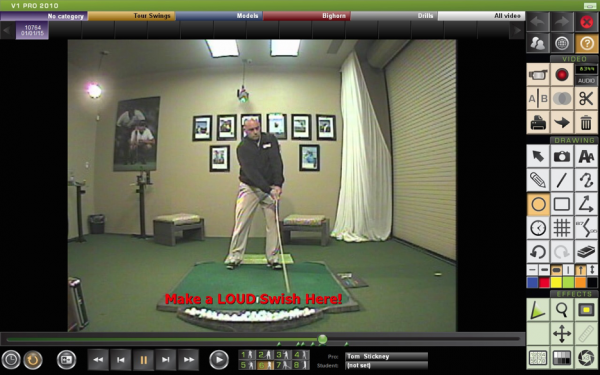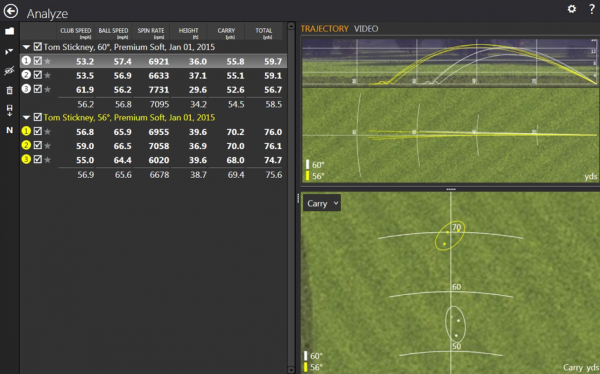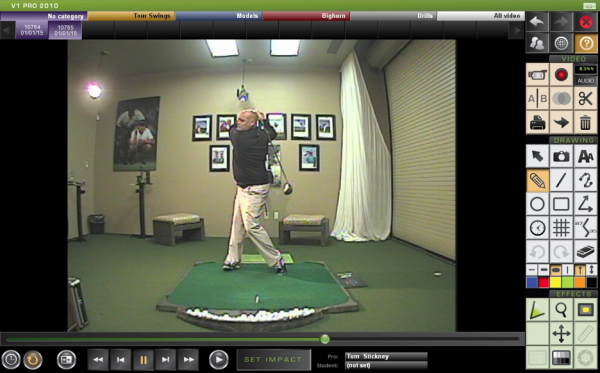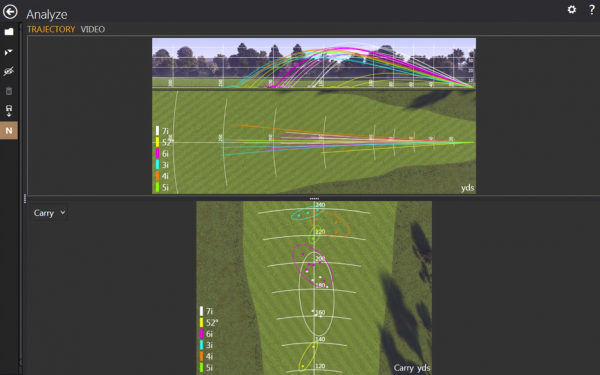Instruction
10 Resolutions to Help Your Game in 2015

If you’re into New Year’s resolutions, you’ve probably already made them — but did you make your 2015 golf resolutions yet?
As an instructor, here’s 10 few things I think you should consider. These drills, assessments and practice plans will have to on your way to playing the best golf of your life in 2015.
No. 1: Create More Speed
Everyone needs more speed in this game — even the longest players in your group could stand to swing a little faster. After all, golfers can always scale back when things are going wrong, but trying to hit your three wood 20 yards farther than you’ve ever hit it? That’s probably not going to happen. And if you’re trying to raise your game to the next level, it’s hard to have success if you don’t hit the ball at least the average distance.
For every 1 mph you add to your club head speed (assuming centered impact), you can gain up to 3 yards more distance. Very few of us will be able to create 10 more mph and still find the center of the face, but if you could find 3, 4 or 5 mph it would be nice, don’t you think?
Use my swish drill to produce more speed. Take an alignment stick and set up as you would normally. Then make a swing trying to make the swish out in front of the ball and as loud as possible. You will hear “more speed.”
Next, take this feeling to the range and try hitting 10 drives as hard as you can. Then hit five drives as you normally would. Using these two drills will help you get faster over time. Try it and you’ll see.
No. 2: Improve Your Wedge Game from 30-to-80 Yards
This is usually the worst part of most amateurs’ game. Regardless of your level of play, you should seek to make your wedge game an asset, not a liability. No one likes to turn a chance to make a birdie into a bogey or worse, and a fat or thin shot from 30-to-80 yards is often the culprit.
Remember that the first key to wedges is to get the ball on the green. Once you can do that consistently, you can then hone in on the hole. If you want to become a better wedge player, you will need to practice and chart your distances and dispersion. You can do this on Trackman or at home on your own. You want to understand how far you carry each shot and what your “miss pattern” tends to be from each yardage so you can plan accordingly.
No. 3: Increase Your Flexibility
I am NOT advocating that golfers spend two hours in the gym each day doing cardio, weights and stretching. If you can, that’s great, but it’s not realistic for most people. There are many things you can do at home to aid your flexibility, however, and one of my favorite things to do is to take a heavy club and use it to STRETCH myself into different positions. What I did not tell you to do is swing the heavy club back and forth.
The stretching I advocate is a way to move your body into positions that it’s not used to so you can find your “normal” swinging position easier. If you’d like more exercises regarding flexibility, strength, injury provention, etc., visit www.mytpi.com, the leader in golf-specific training.
Example: I did not swing into this position at my normal speed. I swung at one-eighth speed and took the club back as far as I could. Then I pushed it a little farther and held it for a few seconds. Then I repeated it a few times SLOWLY so I could feel the stretch.
No. 4: Take More Lessons
If you want to get better at golf and improve your own personal well being on the golf course, you are going to need some help. If possible, I advocate taking a lesson a week. If you cannot, then shoot for one lesson each month. It will help you to make sure you stay on the right track.
You can find a listing of Golf Digest’s Top Teachers by state at this link: http://www.golfdigest.com/golf-instruction/2013-11/best-teachers-state-ranking
It’s always best to find a teacher uses video and some type of launch monitor within their lessons, since most of us need all the help we can get. This listing will help you to find the most active teachers in your area.
No. 5: Audit Your Set Make Up and Get Fit
If I had a dollar for every person who comes into my facility with slick grips, a missing club, and/or a poor set makeup that leaves distance gaps in their game I’d be a member at Bighorn!
There are tools now that help us see if the clubs you have in your bag actually work for your game and answer questions such as:
- Are your lofts and lies correct for you?
- Do you have the right shafts?
- Do you have enough fairway woods, hybrids or wedges in your bag?
- Do you have the right kind of irons for your game?
- Are you playing the right ball?
I would suggest seeking out one of Golf Digest Top 100 Club-Fitters shown at this link and make sure you are on the right track: http://www.golfdigest.com/golf-equipment/2013-05/100-best-clubfitters.
Secondly, take the time to get on a launch monitor and get a “gap” fitting that will show you if you have yardage gaps within your current set.
No. 6: Get a Short Game Lesson
When I ask golfers how their short game is, I almost always hear the same answer. “It’s fine,” they say. But when I watch them play it’s usually a total disaster. Why? Most golfers ONLY care about hitting the ball and they forget that the key to scoring is to have a short game that is not a total hindrance. I have seen plenty of players get around the green in two shots on a par 4 and then take four more shots to get the ball into the hole. Nice double!
Please take a short game lesson so you can better learn to hit a stock chips, pitches and flops around the green and I promise that you will thank me in the end. This is where I see a ton of shots wasted on the course and it tends to get worse over time if not corrected.
No. 7: Work on your Lag Putting
How many times have you REALLY worked on your lag putting? No, I’m not talking about hitting a few 30 footers and calling it a day, but actually hitting super long putts, working on huge breaking putts and putting from different shelves. These are the things that will help you stop three-putting! Everyone can hit the normal putts we have from 30 feet or so on the flattest portion of the green, but it’s not those that give people the problems.
You should spend at least 50 percent of your putting practice on super-fast putts, huge breaking putts, etc., so that you have a feel of how to control your ball on different lines and with different speeds. A great drill to work on is to find a huge breaking putt and work on lag putting it to the hole using as many different “lines” as possible. This will help your visualization, as well as your feel on the greens.
To be a great lag putter, it’s absolutely necessary to understand how different lines necessitate different speeds. Take the time to understand how to do this and you will not three whip it too often in 2015!
No. 8: Learn to Hit the Horizontal and Vertical Center of the Club
Everyone knows that you need to find the center of the club as often as you can, but few know that there are two different places you should be mindful of when hitting shots. You need to control your vertical impact point and your horizontal impact point on the club.
The vertical portion of impact controls your launch and your spin rate. Hitting it low on the face creates a lower launch and gives your ball more spin. Hitting the ball on the high part of the face gives you a higher launch and less spin.
The horizontal portion of impact controls the “Gear Effect” on the ball. If you hit the ball on the toe, you will tend to see the ball curve more left (for righties). Hitting the ball on the heel will cause the ball to curve more to the right. Gear effect can also negate curvature or exaggerate a shot that is curving right-to-left or left-to-right.
Spray your club face with Dr. Scholl’s Foot Spray and you will see what I mean.
Once you establish your usual pattern, take small swings and try to move the impact location back into the center of the face. Doing this will add ball speed and help you to hit the ball straighter and more consistently.
No. 9: Leave Your Ego in the Car
Know your limitations and don’t be a bonehead on the course. If you really were that good, you’d have a lower handicap, so relax and accept your limitations!
Note: This includes myself!
No. 10: Find a “Go-To” Shot Under Pressure
On the range, it’s so easy. We are relaxed and things tend to work, but what happens when it goes bad on the course? Do you have an exit strategy?
A go-to shot is one that gets you back into the clubhouse with the lowest score possible. If you don’t have one, go to the practice facility and find yours. It could be a low cut, a punch shot, or even a big slice. When the chips are down and you are hitting it sideways, trust your go-to shot so you can salvage your round.
- LIKE19
- LEGIT2
- WOW3
- LOL0
- IDHT0
- FLOP1
- OB0
- SHANK1
Instruction
Clement: Laid-off or perfect fade? Across-the-line or perfect draw?

Some call the image on the left laid off, but if you are hitting a fade, this could be a perfect backswing for it! Same for across the line for a draw! Stop racking your brain with perceived mistakes and simply match backswing to shot shape!
- LIKE0
- LEGIT0
- WOW0
- LOL0
- IDHT0
- FLOP0
- OB0
- SHANK1
Instruction
The Wedge Guy: The easiest-to-learn golf basic

My golf learning began with this simple fact – if you don’t have a fundamentally sound hold on the golf club, it is practically impossible for your body to execute a fundamentally sound golf swing. I’m still a big believer that the golf swing is much easier to execute if you begin with the proper hold on the club.
As you might imagine, I come into contact with hundreds of golfers of all skill levels. And it is very rare to see a good player with a bad hold on the golf club. There are some exceptions, for sure, but they are very few and very far between, and they typically have beat so many balls with their poor grip that they’ve found a way to work around it.
The reality of biophysics is that the body moves only in certain ways – and the particulars of the way you hold the golf club can totally prevent a sound swing motion that allows the club to release properly through the impact zone. The wonderful thing is that anyone can learn how to put a fundamentally sound hold on the golf club, and you can practice it anywhere your hands are not otherwise engaged, like watching TV or just sitting and relaxing.
Whether you prefer an overlap, interlock or full-finger (not baseball!) grip on the club, the same fundamentals apply. Here are the major grip faults I see most often, in the order of the frequency:
Mis-aligned hands
By this I mean that the palms of the two hands are not parallel to each other. Too many golfers have a weak left hand and strong right, or vice versa. The easiest way to learn how to hold the club with your palms aligned properly is to grip a plain wooden ruler or yardstick. It forces the hands to align properly and shows you how that feels. If you grip and re-grip a yardstick several times, then grip a club, you’ll see that the learning curve is almost immediate.
The position of the grip in the upper/left hand
I also observe many golfers who have the butt of the grip too far into the heel pad of the upper hand (the left hand for right-handed players). It’s amazing how much easier it is to release the club through the ball if even 1/4-1/2″ of the butt is beyond the left heel pad. Try this yourself to see what I mean. Swing the club freely with just your left hand and notice the difference in its release from when you hold it at the end of the grip, versus gripping down even a half inch.
To help you really understand how this works, go to the range and hit shots with your five-iron gripped down a full inch to make the club the same length as your seven-iron. You will probably see an amazing shot shape difference, and likely not see as much distance loss as you would expect.
Too much lower (right) hand on the club
It seems like almost all golfers of 8-10 handicap or higher have the club too far into the palm of the lower hand, because that feels “good” if you are trying to control the path of the clubhead to the ball. But the golf swing is not an effort to hit at the ball – it is a swing of the club. The proper hold on the club has the grip underneath the pad at the base of the fingers. This will likely feel “weak” to you — like you cannot control the club like that. EXACTLY. You should not be trying to control the club with your lower/master hand.
Gripping too tightly
Nearly all golfers hold the club too tightly, which tenses up the forearms and prevents a proper release of the club through impact. In order for the club to move back and through properly, you must feel that the club is controlled by the last three fingers of the upper hand, and the middle two fingers of the lower hand. If you engage your thumbs and forefingers in “holding” the club, the result will almost always be a grip that is too tight. Try this for yourself. Hold the club in your upper hand only, and squeeze firmly with just the last three fingers, with the forefinger and thumb off the club entirely. You have good control, but your forearms are not tense. Then begin to squeeze down with your thumb and forefinger and observe the tensing of the entire forearm. This is the way we are made, so the key to preventing tenseness in the arms is to hold the club very lightly with the “pinchers” — the thumbs and forefingers.
So, those are what I believe are the four fundamentals of a good grip. Anyone can learn them in their home or office very quickly. There is no easier way to improve your ball striking consistency and add distance than giving more attention to the way you hold the golf club.
More from the Wedge Guy
- The Wedge Guy: Golf mastery begins with your wedge game
- The Wedge Guy: Why golf is 20 times harder than brain surgery
- The Wedge Guy: Musings on the golf ball rollback
- LIKE86
- LEGIT13
- WOW6
- LOL1
- IDHT0
- FLOP4
- OB1
- SHANK8
Instruction
Clement: Stop ripping off your swing with this drill!

Not the dreaded headcover under the armpit drill! As if your body is defective and can’t function by itself! Have you seen how incredible the human machine is with all the incredible feats of agility all kinds of athletes are accomplishing? You think your body is so defective (the good Lord is laughing his head off at you) that it needs a headcover tucked under the armpit so you can swing like T-Rex?
- LIKE0
- LEGIT2
- WOW2
- LOL0
- IDHT0
- FLOP0
- OB0
- SHANK2
-

 19th Hole2 weeks ago
19th Hole2 weeks agoDave Portnoy places monstrous outright bet for the 2024 Masters
-

 19th Hole3 days ago
19th Hole3 days agoJustin Thomas on the equipment choice of Scottie Scheffler that he thinks is ‘weird’
-

 19th Hole2 weeks ago
19th Hole2 weeks agoTiger Woods arrives at 2024 Masters equipped with a putter that may surprise you
-

 19th Hole3 days ago
19th Hole3 days ago‘Absolutely crazy’ – Major champ lays into Patrick Cantlay over his decision on final hole of RBC Heritage
-

 19th Hole2 weeks ago
19th Hole2 weeks agoTwo star names reportedly blanked Jon Rahm all week at the Masters
-

 19th Hole1 week ago
19th Hole1 week agoReport: LIV Golf identifies latest star name they hope to sign to breakaway tour
-

 19th Hole1 week ago
19th Hole1 week agoNeal Shipley presser ends in awkward fashion after reporter claims Tiger handed him note on 8th fairway
-

 19th Hole1 week ago
19th Hole1 week agoBrandel Chamblee has ‘no doubt’ who started the McIlroy/LIV rumor and why





















Regis
Jan 7, 2015 at 2:13 pm
Tom you could take the boxes and boxes of books, tapes and DVD’s I have and edit them into these simple pieces of advice and it’s all I really need. Following that advice? Thanks
Tom Stickney
Jan 7, 2015 at 7:55 pm
Reg– thx!!
TR1PTIK
Jan 6, 2015 at 8:22 am
Tried out the Dr. Scholl’s for the first time over the weekend. It’s far too cold to go to the range and I don’t have a net to use in the house, but I do have a hitting mat, rubber tee holder, and plenty of golf tees so I went to work. The first swing was dead center horizontally, but a little low. The next one found the mid-toe area. After a few more swings (less than 10 altogether) I could find the horizontal center without problem and just need to adjust either ball position or tee height to make sure I’m striking the ball at the vertical center as well. Liked the tip about lag putting as well because while some would say it is more important to work on putts inside 10ft (and it certainly is important), how many approach shots stop that close to the pin? If I could get more of the long putts to stop within tap-in range, I’d probably make par a little more often and perhaps even sink a nice birdie bomb every once-in-a-while.
tom stickney
Jan 6, 2015 at 11:54 am
tr1- glad you enjoyed the article; good luck!
Jake Anderson
Jan 6, 2015 at 8:05 am
I have to disagree with some of the points. For example the part on lag putting. Unless you have unlimited time lag putting is a waste of it. It is not effective. Rather, it is important to improve putting within 10 feet. Also, the point about improving wedge-play within 30 – 80 yards is not ideal advice. While it is important to hit the green safely from these distances, it will do much more good to a person’s game to improve play from 150 yards to 200 yards, because that is the usual length for approache shots which influence scoring way more than short game prowess.
tom stickney
Jan 6, 2015 at 11:57 am
Jake- if you can’t lag it or hit it inside 10 feet then what good is working on 5-10 footers? Secondly, weekend golfers don’t have the ability to hit the ball on the green from 150 to 200 yards with any consistency thus the shorter wedge shots make more of an impact.
Jake Anderson
Jan 8, 2015 at 8:54 am
Maybe you are targeting absolute beginners. Then your advice might be correct.
The majority of golfers who keep a handicap are between 8 and 25. These players can lag to within ten feet regularly and would most improve their score by hitting more greens and not by learning to scramble better. Therefore, while it is not wrong, that improving lag putting and wedge play helps, it is definitely not optimal practice. You need close range putting an GIR!
I hope you can appreciate this point and retract your previous advice.
Tom Stickney
Jan 8, 2015 at 9:55 am
Jake….every shot counts is a great book but it’s slated to professionals. The 10 or below has different goals but I still hold true to my comments over a 12 handicap player based on 21 years on the lesson tee full time
larrybud
Jan 9, 2015 at 8:35 pm
20 handicappers should work on not spraying the ball off the planet. 3 off the tee 4 or 5 times a round are killers.
Tom Stickney
Jan 10, 2015 at 8:30 pm
Larry…the big miss is a killer
other paul
Jan 6, 2015 at 2:01 am
Controlling strike location on the face of a driver sounds pretty tough. I can miss all over just aiming for the middle. What if I blow apart my adjustable hosel while trying go hit off the heel? ????
Tom Stickney
Jan 6, 2015 at 2:44 am
Not sure why you’d want to hit the ball anywhere but the high center of the driver.